Johannesberg,The CK Route (proposed name)
5.10b, AI3, Grade V (unconfirmed)
August 27-28, 2005
In a decade of playing in the Cascades I've never had a route get under my skin like this one did. I don't remember the first time I saw it as a climbable line, but it must have
been driving out after Jens and I first climbed Johannesberg via the Cascade-Johannesberg couloir route. It was the glacier that noticed: A slender, curving, broken white line, unvisited by any other
humans. As I've gotten older I've become more fond of remote, quiet, un-peopled places. That Jberg has no easy way up or down causes it to hold special appeal to me.
There are lots of pictures of Jberg floating around, but it's north face is large and in a tight valley, so getting *detailed* pics is a challenge. I scrounged the Internet and
reviewed what I'd taken driving out from the C-J climb in 2001. At that time Jens and I had been climbing a lot of moderate rock together and felt comfortable simulclimbing to about 5.8 or so. It was
in that context that we drove up the Cascade River Road on August 23, 2002.
Our plan was to sleep a few hours that evening and then send the route in one long push starting around midnight. We sat in the parking lot and studied the pictures and looked up
with binoculars. In the face of the unknown we just couldn't wait and decided to dispatch the initial rock portion of the route that evening and make a bivy near plentiful water on the slabs above the
prominent waterfall. From the comfort of the parking lot we estimated that we could get to our bivy site with only one belayed pitch, soloing or simulclimbing the rest.
And it was with that bravado that we walked down the road from the lot at about 4:00 in the afternoon. Cascade Pass is an amazing place. It is at the head of a valley filled with
glaciers and rocky peaks. The summit of Johannesberg is 4600 vertical feet and less than a horizontal mile away from the parking lot. The approach for the Cascade-Johannesberg route is an easy 20
minute walk from the lot to the base of the avalanche fan. It literally is *right* there. And yet, with no easy way up or down, it's also very far away, especially when one is on the summit looking
down at the cars and people in the parking lot and the setting sun.
To the west of the C-J couloir there is a prominent cleft in the north face of Johannesberg that contains two waterfalls. The larger of the two is mostly free-falling down
overhanging cliffs. It was just to the climber's left of this waterfall, at the entrance to the cleft, that we began climbing back in 2002. In mountain boots it was clear from the beginning that we
would not be soloing or simulclimbing: The rock on Jberg is consistently steeper that it looks and also quite compact; it offers little gear.
As I recall now, Jens and I climbed 4-5 pitches that afternoon, ranging from 4th class to vertical brush. At one point my right foot poked through the bramble that I was climbing
and though the hole I saw nothing but air. As the sun set we arrived at the top of the little tower we'd expected to dispatch in a matter of minutes without a rope. The next pitch started by stepping
across a two foot cleft from the top of the tower to the adjacent blank face. The belay we had was nothing more than decorative, there was no gear on the face, and the tower edge of the cleft, where
the rope would hit in a leader fall, was sharp. We evaluated our options in the fading light. We'd been on route for over two hours and much more than half of the technical rock section remaining
above us, including the part that actually looked hard from the road. The beer in the car called.
We placed one nut in a shallow, angled crack and used it as a safety as we downclimbed. We chose a different way, one that led directly toward the waterfall in the heart of the
vertical cleft on Jberg's north face. To our surprise we left only that one nut and, having seriously humbled us, Johannesberg let us down quickly and with no brush. This 'better way' was not lost on
me. Before 9:00PM we were drinking beer and laughing at the ass-kicking we'd been handed.
Somehow three years slipped behind me before the right motivation and weather showed up. Despite saying he wasn't interested in trying it again, it was Jens who finally suggested
it as an objective. For my part, I was both afraid of failing again and I'd grown accustomed to looking through my stack of pictures imagining what the route would be like. Jens and I have partnered
for other first ascents, but this is the only one that I'd picked out.
It's just after 1:00 AM when Jens shows up. I'm buzzing with excitement and caffeine. I've not climbed much with Jens lately, as my interests have drifted back toward aesthetic
but easy routes on the volcanoes. But here we are in the car driving to something hard and exciting in the middle of the night, just like we used to.
Fueled by chocolate, coffee, and Red Bull, we arrive at the Cascade Pass parking lot around 3:30 AM. It's cool and quiet and starry. I'm as excited as I've been in a year to go
climbing. Even in the faint night light the huge north face of Johannesberg looms above us. At 4:20 AM we're packed. "Let's send this thing, Jens."
Under headlamp we walk down the road to the first hairpin and then drop down and cross the creek. From past experience we know to walk down the creek until the brush on its south
side clears and then start a rising traverse. We know the way now and in less than an hour we arrive at the base of the waterfall in the heart of the cleft. It is a dark and ominous place and we don't
linger. We solo up two pitches traversing up and left, out of the cleft. It feels surreal to me- like the first moments after waking from a dream when I'm trying to sort out what is real. At 5:40 AM
we arrive at a familiar ledge. A narrow ramp leads up, left, and around the corner. We decide to rope up and change to rock shoes here.
It's cool and dark so we change shoes and rope up quickly. Jens takes the sharp end of our 8mm 60 meter rope and cautiously stands up on the ramp. It looks easy but isn't. The
rock is moist from moss and other vegetation and polished where it's dry. After a couple tentative moments Jens finds his groove and disappears around the corner. Thirty minutes later the rope is out,
but still moving. As we've done so many times, I dismantle the belay and we simulclimb. As dawn breaks I arrive at the top of the tower from which we'd retreated in 2002. The skinny rope runs up the
blank face and around the corner. I pause and look for the nut we left in 2002 but it's gone. Then I step across the cleft. There just isn't a good hold there; it's balancy and thin and I know how
much that rope stretches. I get the best holds I can find and pull onto the face. The first couple moves are the hardest, perhaps mostly because for three years they were what had stopped us. I'd rate
it 5.8.

The Cleft Waterfall from the top of the tower. Winter fun anyone?

The face climbing is actually fun once I'm committed, and I follow the rope up and left around the corner. Shortly above I find Jens belaying from a stance on a brushy face. It's
about 6:45 AM.
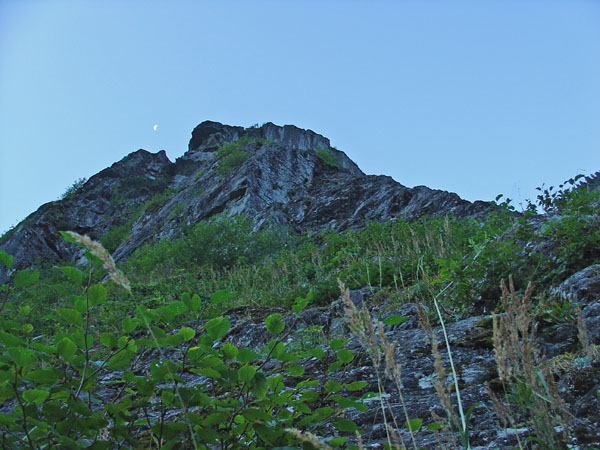
Up into no-man's land. Belayed pitch 2, up to and around the arete, up a fun face and back left onto the brushy ledge. About 5.7.

From the waterfall we've now climbed four pitches, two solo and two as one long pitch and we're now one pitch higher than our 2002 high point. As daylight comes to
us, the top of the steep rock section looks so close. Above us is a prominent overhanging prow of rock. It catches my eye, though I don't know that we'll have a close encounter with it when the day is
older. In the name of speed, Jens stays in the lead and climbs up to an arete and out of sight. I hear him call 'off belay' this time and I follow up. The face on the back side of the arÍte is clean
and fun, reminiscent of the slab pitch on Art's Knoll.
I join Jens on the ledge and look up at an angling, moderate-looking face that leads into more brush. At this point I concede the leads to the slabs to Jens. He's in
far better rock shape than me and time is of the essence. Jens starts up, then comes back down and leaves his pack. "We'll haul them on this pitch, Loren."
I don't see why, but defer to the leader and watch as he climbs carefully up into the brush. Jens calls off belay in the scrub trees and I rig the packs for him to
haul. They get caught in the brush and so I second up and monkey around to free them. This pitch, #6 overall, is much harder than it looks at about 5.9.
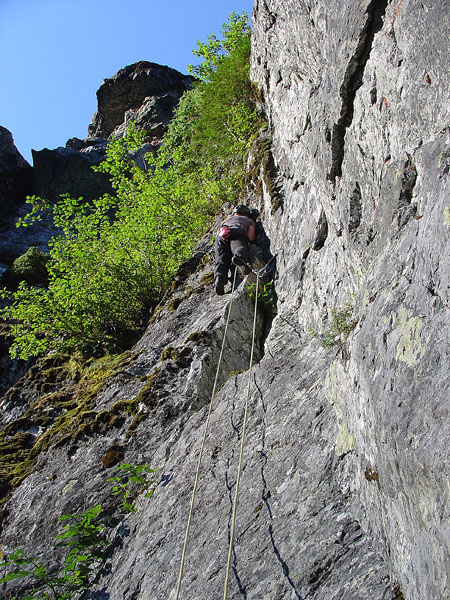
Belayed pitch three, actual pitch 5: Deceptive looking and solid 5.9.

Pitch six is the tree-thrutch pitch up through scrub fir and slide alder. Jens hates climbing like this, and brush in general. But in this case the brush provides
security, even if it takes a lot of effort to force a way through. Shortly after 8:30 AM Jens call off and I scrumble up to join him in a remarkable location.

The air down there. Belay for pitch four (actual pitch #6), the tree-thrutch pitch.

We are on a large, brushy ledge at the foot of a sheer, overhanging wall. The wall is painted green, red, and orange with Jackson Pollock-style spatterings of
lichen. We feel confident that one more pitch will get us to the slabs, but for five years this very spot has been the big question mark. A loose crack presents a possible aid line, but our rack is
too small. We traverse up the ledge toward a ramp near the head of the waterfall. It's very polished and (like so much of this route) steeper than it looks. There isn't even a seam where it meets the
headwall. We make a belay and Jens starts up, but quickly turns around. With our skinny rope the climbing is too hard without gear.
We spend about an hours talking and hunting. Jens eventually finds the way by climbing down and out of the cleft onto a ledge that leads us to a belay directly under
the prow that caught my eye hours earlier.

The evergreen ledge and the overhang that almost denied us. We eventually went down and around the corner to the right.

We gaze up in silence. While the previous hard pitches looked easy, this one looks hard. A blank slab led up to a dirty, mossy chimney- obviously a water course
earlier in the season. A tree on the ledge provides a solid belay and Jens starts up. He gets no gear on the slab but finds some as he nears the chimney. Moss and dirt showers down on me. I can't look
up or takes pictures. "Make this the best belay of your life, Loren."
I oblige and am thankful as I see Jens placing several pieces in the corner. He is cautious and confident and with a grunt pulls over the lip at the top and
disappears. The rope dangles out in space, making obvious the overhanging nature of the pitch. I make ready the packs for hauling. It's easier on this pitch with no brush. Then I follow. The slab is
technical but there. The corner is messy and chunks of moss break off under my feet. I thrutch and sweat and swear. For the last ten feet I have Jens put tension on the rope to help me. Covered in
dirt and sweat and breathing hard I finally flop over the top onto a mossy ledge at 11:09 AM and look up. "Fucking-A, Jens, that was a brilliant lead."
It turns out to be the crux of the route at 5.10b. In a crack at the top we decide to leave one nut as witness to our passing. I quickly catch my breath and then
start up lower angle terrain. A bit of third class rock and some brush hauling brings us to immaculate, glacier-polished slabs.
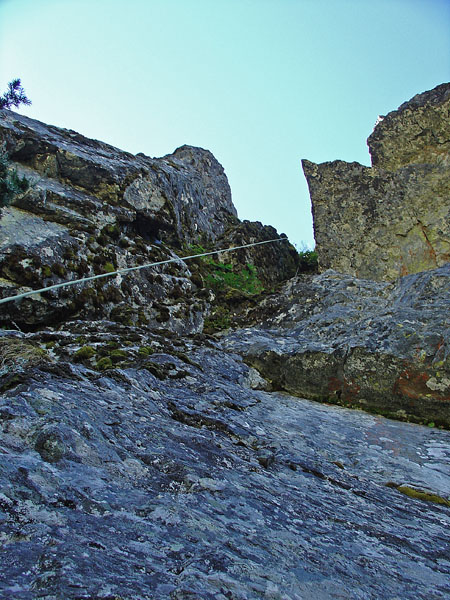
The crux pitch, number 5 (actual pitch #7): Decent gear, mossy, thrutchy 10b. Nice lead Jens!

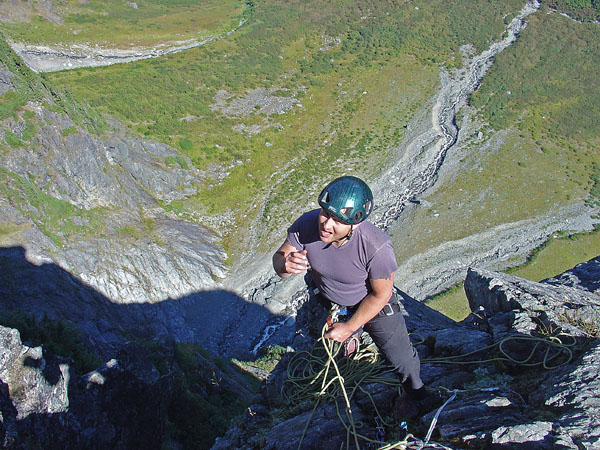
Jens at the top of the crux pitch. "Go up to water, dude!"

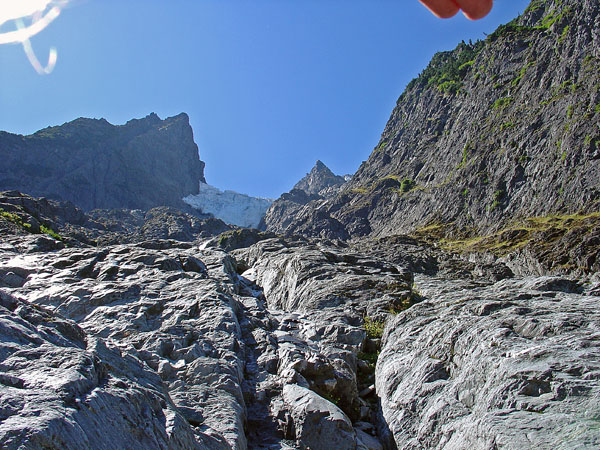
Easier terrain, must move quickly: Looking up the slabs at the left ice cliff.

I'm in heaven here as we walk up the slabs in a place no person has ever been, yet I'd visited so many times in my imagination. No cairns, no trails, no footprints,
no tat, no garbage. It's pristine. We walk right and stop at the creek that originates in the glaciers above us. I drink two quarts of water, eat a couple bars, and change into boots. It's 11:50AM as
we rise and start walking up. We move leftward and we go up to get out of the fall line of the imposing ice cliff above us. It soon becomes clear to both of us that our original plan to directly climb
the cliff is not going to work: The glacier has retreated to the bottleneck and steep, polished slabs guard it. The rock face to its right looks promising and we choose a line between two cascading
creeks running out of the right-hand ice cliff.
To get there we have cross under the left ice cliff and in my haste I make an error, the most glaring to me of the trip: I opt to not take the time to change into my
rock shoes. We start up the polished, crackless slabs unroped with me in my rigid-soled Trango Ice boots. We solo up 2-3 pitches ranging from 4th class to mid 5th. The exposure was significant and the
ice cliff loomed above us. No place to dawdle and no place to hurry. I cursed aloud and questioned my motivations. Time slowed and my perception was that hours had passed when we finally pulled over
the lip onto easier terrain. In reality we'd left our water break less an an hour earlier and had been on the steep slabs only 20 minutes or so.
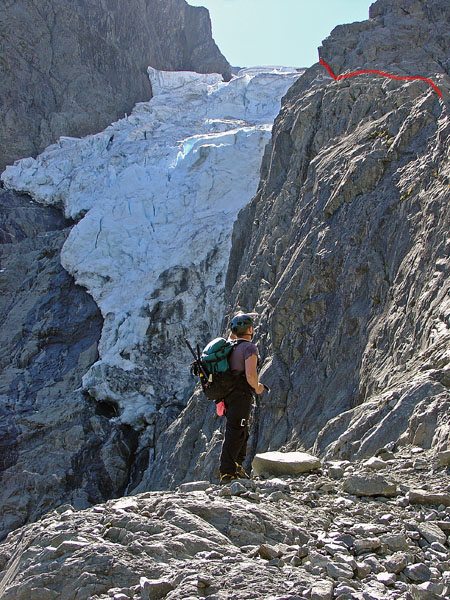
Jens above the solo slabs scoping a way around the ice cliff. We ended up climbing rock to an obvious seam where the red line angle up.

We moved quickly until we were no longer under the direct fall line of the right ice cliff, then stopped to change back into rock shoes. Minutes after a loud crack echoed
through the rock amphitheater and we turned to see a huge chunk of the right ice cliff calve off and spill down the slabs. As the debris ran out far below we turned toward each other. Slack-jawed
silence said it all.
We stayed near the lip evaluating options for gaining the glacier. As we ascended the rock a wall to wall break in the glacier became obvious and we opted to try to stay on the
rock to pass it.
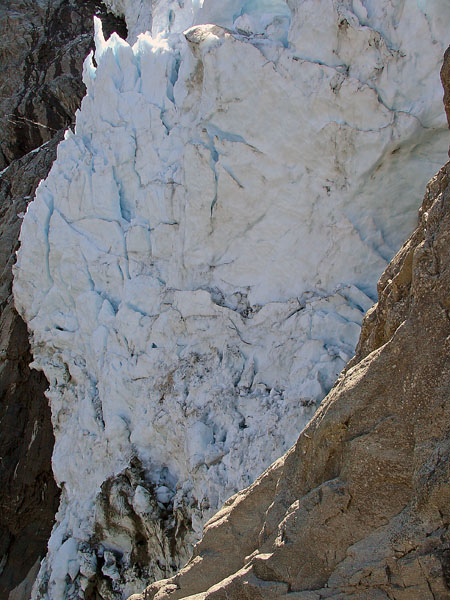
The left ice cliff. Yowza.

We continue scrambling up on the rock as it steepens. At the end of a 4th class gully we set a belay and Jens leads out along a horizontal seam in the rock for a
pitch. I join him and the climb 20 feet past and down, placing a couple pieces along the way, and finally land on the glacier. I flop up onto a block of ice and change back into my boots, this time
with crampons and ice tools. This is my terrain, where I feel most comfortable, and I'm raring to go.
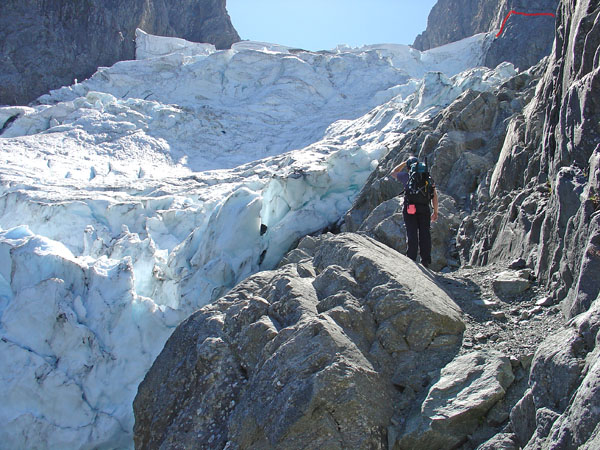
Stupendous scenery and position. We gained the glacier by climbing along the horizontal seam just above the red line.

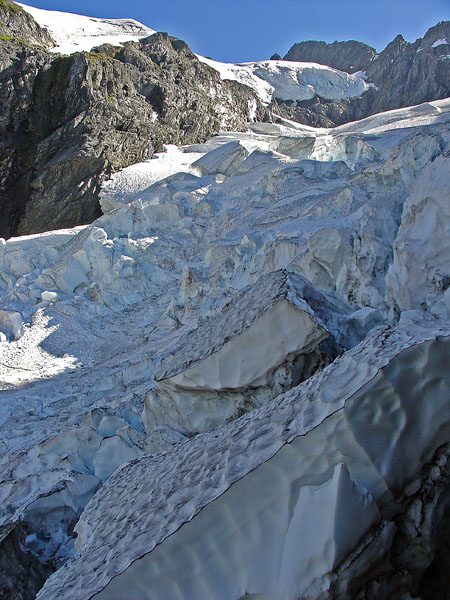
The glacier from the end of the rock climbing at 2:36 PM. We put on crampons and gathered water from under the block at the bottom.

As we sit I realize that we've now cleared two the three major obstacles on the route: The difficult rock climbing low and gaining the glacier. I also realize that
the glacier may not go and that there is no way to rappel down the steep slabs we'd soloed up and watched icefall scour. We are committed to going over now, somehow. It's also after 3:00 PM and I'm
starting to wonder exactly how warm one sleeping bag and one space blanket can be for two people in the rain predicted for that night.
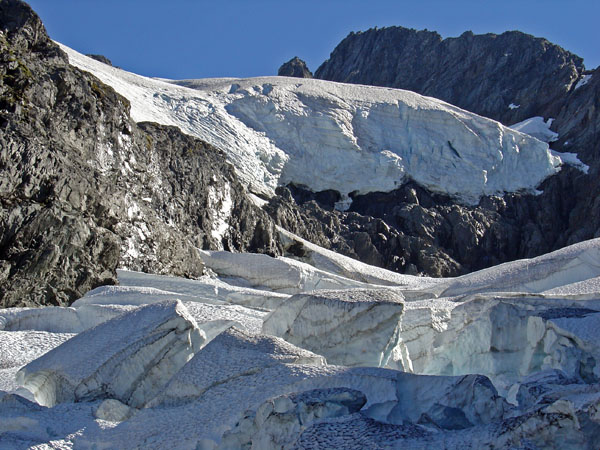
The upper glacier. We hoped the ramp under the upper cliff we give us access to the arÍte of the NE Buttress route, if we could get to it.

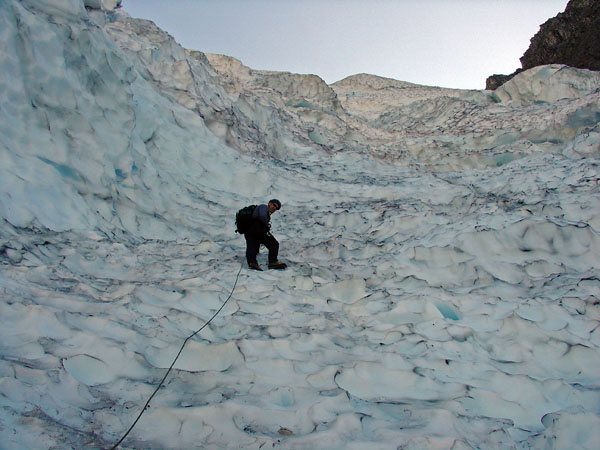
Making time on easy ground.


Not so easy ground.

Climbing the glacier was challenging and so much fun. We make steady, careful progress, weaving back and forth and in and out more times than I can count. I start
feeling like the mountain is tossing us a bone now, as each time we come to a seemingly insurmountable obstacle we find a weakness that allows us to pass. We work together like only two people who
have climbed many routes and for many years together can: Wordlessly swinging leads, efficient with energy, and every time there is a difference of opinion deferring to the person who is correct: It's
both uncanny and terrifically comforting.
The last crevasse stretches wall to wall, too. We start at climber's left and walk it's length to the right. With the shadows growing we find a way to climb down
into it, then at the moat between it and the rock we find a way to climb out at AI3+. This lead is mine and as I pull over the top I can see that no more obstacles are between us and a rock ramp that
leads to the upper section of the NE Buttress route. My hoots and hollers echo off the rock walls. We're not at the summit or safe, but now we know we can get to the summit. It's 5:42 PM as Jens and I
set off together traversing across this unnamed glacier for the last time.
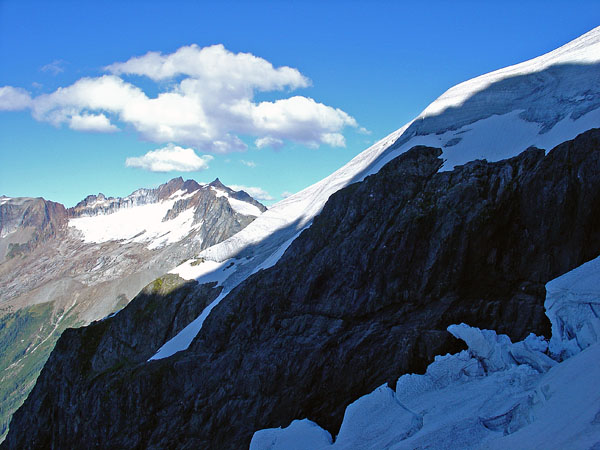
Boston and Sahale in the distance, the arÍte of the NE Buttress in the foreground.


The snow ramp and "Thank God" ledge. Now we know we can get to the summit.

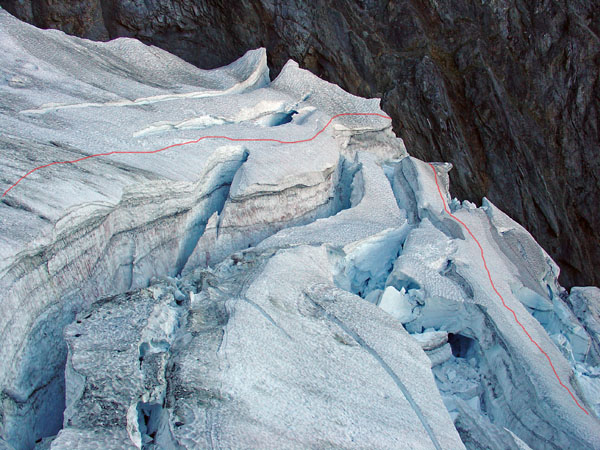
The crux on the glacier was passing the last crevasse: We found a ramp into it and climbed up between the ice and rock. AI3+.

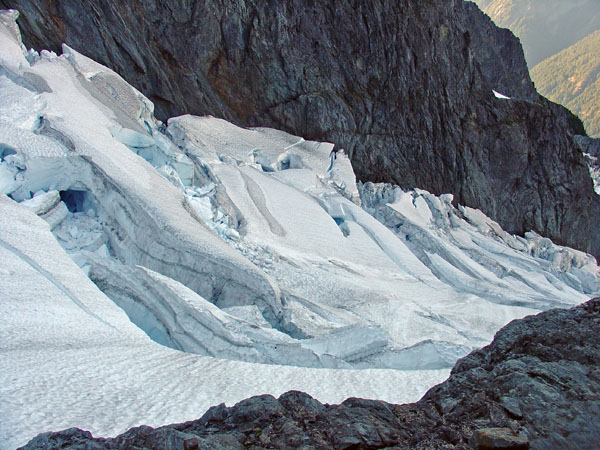
Most of the glacier. The spot where we downclimbed from the rock is out of frame to the right.

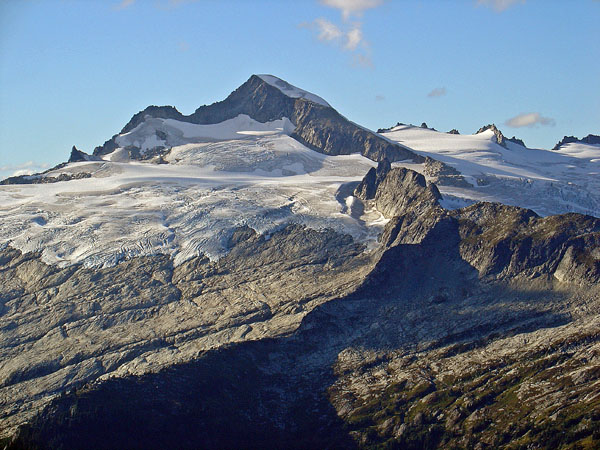
Eldorado. Where is the snow?

The ramp looks far off, but, after collecting some water, we are on and across it. It's easy walking to the foot of an AI2 slope up to the crest of the snow arete
and the NE Buttress route. Three simulclimbed pitches and I'm standing in the sun again and looking at boot tracks leading up the arete. The discovery and publication of the "Doug's Direct"
descent route have made Johannesberg a much more popular objective that is used to be.
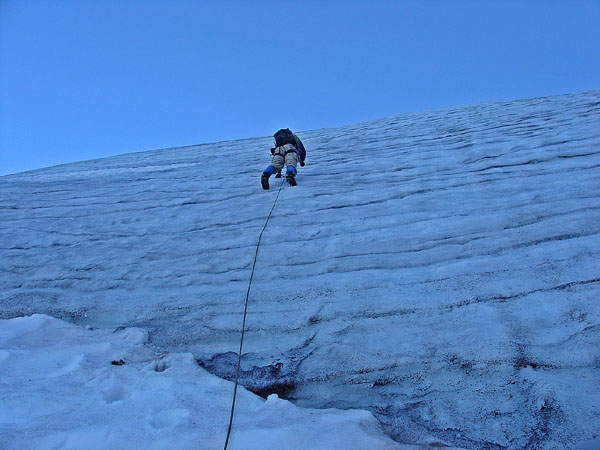
Climbing up to the arÍte. Photo by Jens.

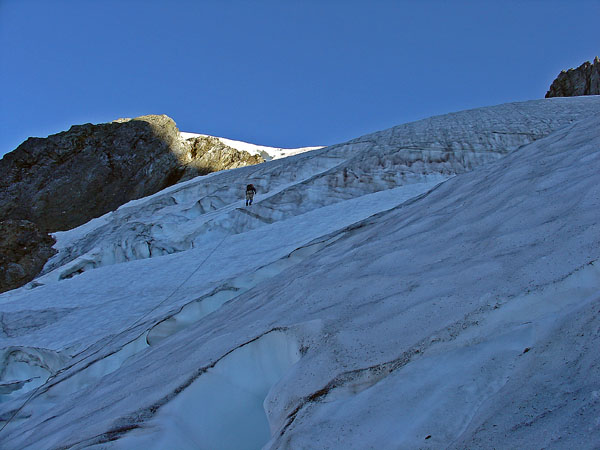
6:38 PM and we're pressing on to the summit. Photo by Jens.

We're both tired and fatigued now, and I always seem to slow down close to the summit anyway. Though we'd joined the NE Buttress route at about 6:30 PM, it's 8:00 PM
when we both finally reach the summit after an icy traverse and rocky final scramble. Evening alpenglow is about us as we begin to contemplate the tedious descent. I let those worries go for a few
minutes and sign the summit register, sparingly sip some water from my one quart, and eat. I look down at the route: It'll never be a classic, but it has everything I enjoy in a climb: Beauty, remote
feel, no crowds, challenging rock climbing (for me), challenging glacier climbing and navigation, and lots of puzzles to sort out. I'm stoked too, that Jens and I climbed well together, finishing this
new route in 13 hours 40 minutes from the parking lot. It's a time that could and hopefully will be bested, but I also still have some energy reserve for the descent and the night out. We discuss a bivy there on the summit or along the summit ridge, but we're both feeling okay and with rain predicted for that night we're motivated to get down as far as possible while the weather is good.
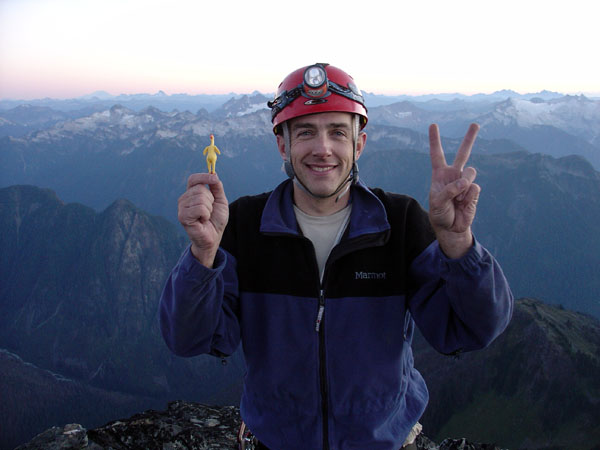
The alpine assault chicken (the yellow thing, not me) at the summit.

On somewhat familiar ground now (this is my second summit and Jens' third, so between us we've traveled the east ridge five times) we start descending to the east.
The first part of the descent is traversing the ridge. This goes more quickly than I expect and soon we start down the loose gullies. It's dark now and we're moving under headlamp. I'm very aware of
the consequence of twisting an ankle (I'm prone to this) here, so I'm moving carefully. We make rap after rap in the dark, sometimes searching a bit for stations but only once getting the rope
stuck. Jens is far ahead of me when we reach the steep heather and starts scouting for the rap station that will take us down into the distinctive white staircase. He's rigged the rap when I get
there. Two raps lands us in the middle of nowhere. We hunt around and eventually rig enough crappy pieces together to make one last rap. In 2002 we'd made a short downclimb from there to the moat. The
snow has receded so much that now even an additional 30 meter rap leaves us short of the snow. When we get to the moat it's loose and dirty and nasty- typical of terrain that has long been covered by
perennial snow. I guess it was between 1:30 and 2:00 AM when we pull the rope for the last time. I'm tired and fatigued, but in a zone where I know there is business to be done and for hours I've not
been getting any more tired. I can't remember as I write this if we put on crampons, but I think so. The snow at the moat was hard and icy.
It somehow felt strange to me to not go up the C-J Col, a place of remarkable transitions from steep snow and ice to rock when climbing the C-J Couloir route, but on
tired, sore knees I tottered slowly down the perennial snowfield on the south side of the couloir. A few days later I wrote this to a friend about these moments:
As I walked stiltingly down the little snowfield below the C-J Couloir at 2:00 AM Sunday morning, tired (90 minutes sleep in the previous 44 hours),
thirsty, hungry, and hoping to find a bivy soon, I looked up and saw, for the first time that night, a sublime, unfathomable, undeniable little cluster of stars shining down
on me. I think you know the one. Warmth and energy filled me. A broad smile creased my weary face and my eyes brightened. I thought to explain it to Jens, but stayed silent instead...
It was one of those perfect little moments of unexpected joy that I've grown to appreciate as much as anything else when I'm climbing. At the end of the snow we stop
and pull off crampons. Just ahead of me in the rock, Jens calls out that he's found a bivy site. This is most welcome news. I stumble down to him and we spend a few minutes removing larger rocks and
putting on clothes. After 22 hours on the go and on guard I'm still a bit wired and my body takes a few minutes to relax. We split my 30 degree half-zip down bag and the space blanket. I sip some
water, saving 1/2 a quart for the morning, which means I've had 1/2 a quart in the last 8.5 hours. Then my body shuts off like someone pulled the plug. The wind kicks up a bit over night, tearing the
space blanket to tatters. At some point Jens' shivering wakes me and I insist that we dispense with any half-planned-bivy homophobia and that he put his back against mine. That stops the shivering
instantly and we are both back asleep in seconds.
Jens is not given to sitting around at all, and certainly not when he's cold. I'd expected to be roused at first light or even before, but it's after 6:30 AM when I
wake to morning sun on the Northeast Face of Formidable. I revel in waking warm and having my first sight be our previous first ascent lit up with with sunshine and not soaking wet. We eat a bit and
sip some water. I stretch and begin to feel the effect of the previous day. There isn't much to pack or do so we're moving shortly after 7:00 AM, off to find the new descent route, Doug's Direct. I'm
super stoked that the weather has held our for us because it means that we won't have to search blindly in clouds for the notch that marks the key to Doug's Direct.
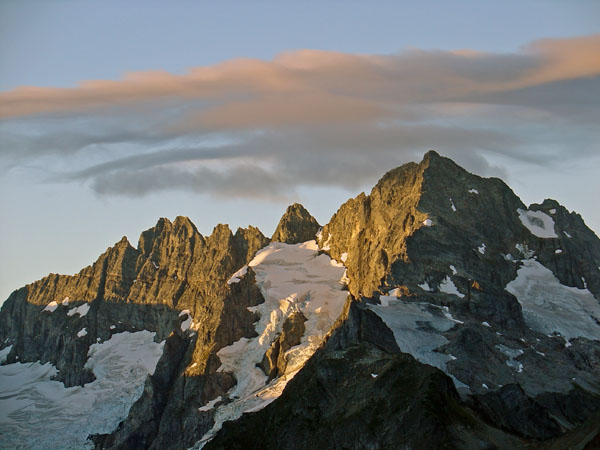
We survived the descent: Formidable at daybreak from our half-planned bivy below Cascade-Johannesberg Col. Jens and I first teamed for a first ascent in the Cascades
on its sunlit northeast face.

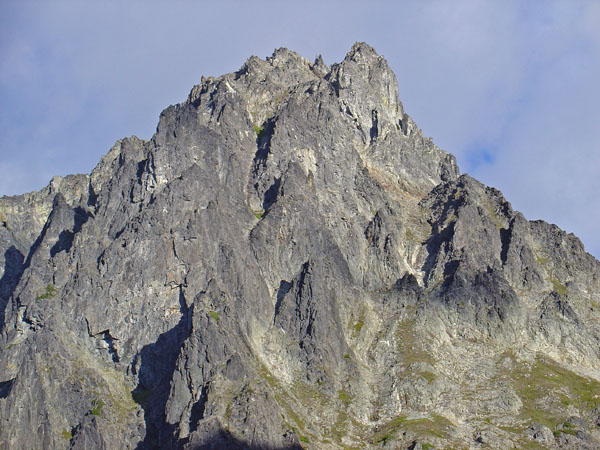
The upper reaches of Johannesberg from the south. Big mountain. Lots of choss.

Jens and I both drag ass getting to the Doug's Direct notch. First we descend under an arm of Cascade Peak and then start a 2000 vertical foot rising traverse across heather
slopes to the rocky notch. The mountains continue to smile upon us with blue skies and then, with us still woefully short of water, provide a bounty of blueberries almost the entire way to the notch.
Aside from being the most perfect food for two dehydrated people who'd been eating nothing but bars for 40 hours, they are the perfect excuse to stop...frequently. I'm not in any hurry, but we make
steady progress up, frequently checking a picture of the notch to make sure we're headed to the right place. A large cairn confirms that we've arrived in the correct location. We take a break and I
manage to get a call out to my wife, but the phone balks at making a second call for Jens. After a nice rest in the sun, some food, and the rest of the water, we start down. I'm hoping for nothing
more than 3rd class, as my knees are getting very sore. I get my wish, but I'm still slow. Jens moves ahead and then waits, never getting out of shouting distance. The descent forces us to our right,
away from the direction we want to go, but it's still a much better option that Gunsight Notch, and the C-J couloir has melted out this year (sadly).

Johannesberg from near the "Doug's Direct" col.

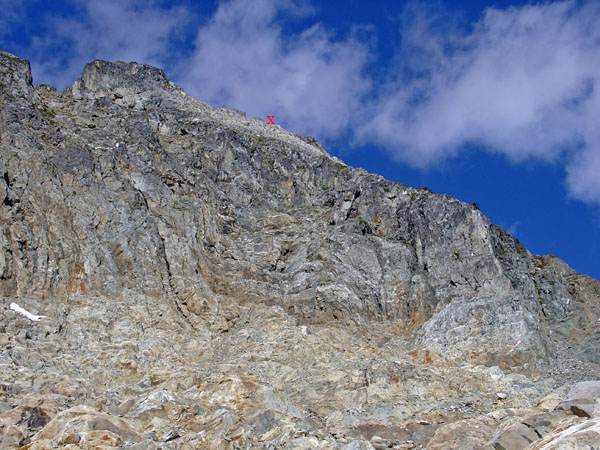
Doug's Direct: Walk easy slopes to the skyline, then up to the white rock and the "X".

I'm going slower and slower as my knees get more painful and I worry about my ankles. I'm determined to avoid twisting one and having to slow down a lot. We get
water just before we join the way-trail of the Ptarmigan Traverse and continue down toward a clutch of people at Cascade Pass. They appear to be gawking up at us, but as we clear a rise we surprise a
nanny goat and her kid and all the binocular ogling makes sense. We stop again at Cascade Pass and I eat the last of my food, drink, and take a handful of ibuprofen. I know Jens detests the trail down
from the pass, which features 36 switchbacks and takes about five miles to cover less than one mile as the crow flies, so I offer to him that he can go down the climber's route and I'll walk the
trail- I'm in no mood for any additional uneven ground, even if it means walking an extra four miles. He's in good spirits though and decides to stick with me. An hour of easy walking and we're back
at the car. This time there is no flat tire and not fender-bender.
So there it is. The CK Route. First ascent, Loren and Jens, August 27, 2005. Grade V, 5.10b, AI3 (unconfirmed). Someone else go climb it and downgrade it.
In response to a TR that Jens posted about this climb, the route was denounced as terribly dangerous and Jens and I were dressed down for taking risks unfitting for
people who are husbands and parents. My first response was to tell those people, none of whom had been on the route, to go fuck themselves. But after a day of thought I wrote a more wordy, less
defensive response,
which you can read (along with the criticisms that weren't edited) here.
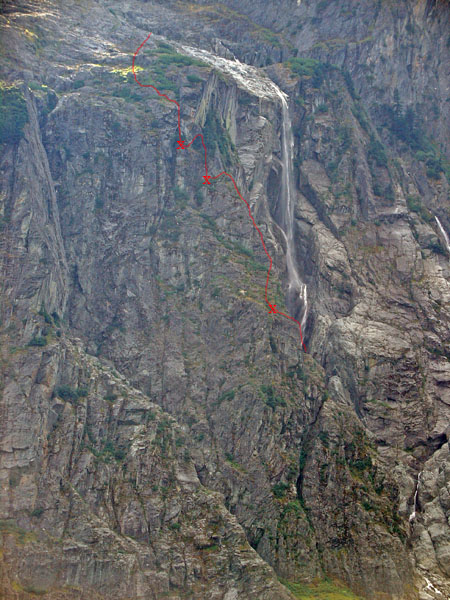
Our approximate line. We're still sorting it out.

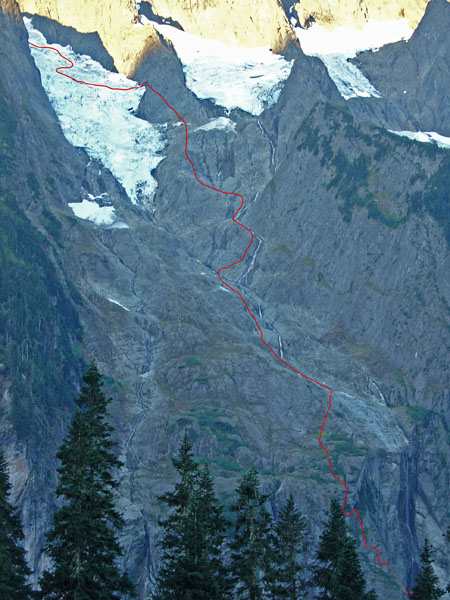
Another estimated line.

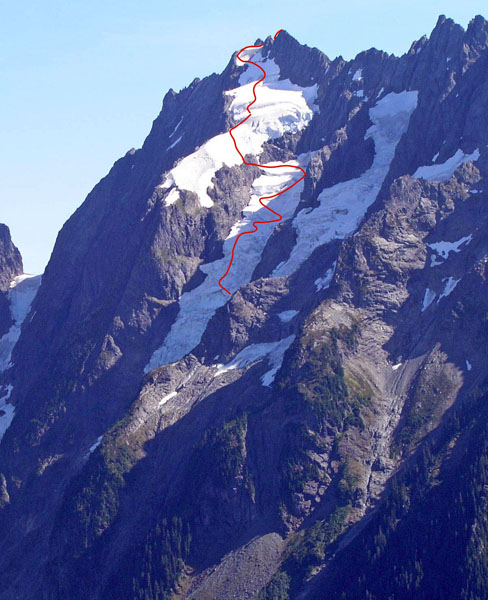
Our approximate line on the glacier. There was more weaving that what is shown. Thanks to Chris Kouba for permission to use this image.



